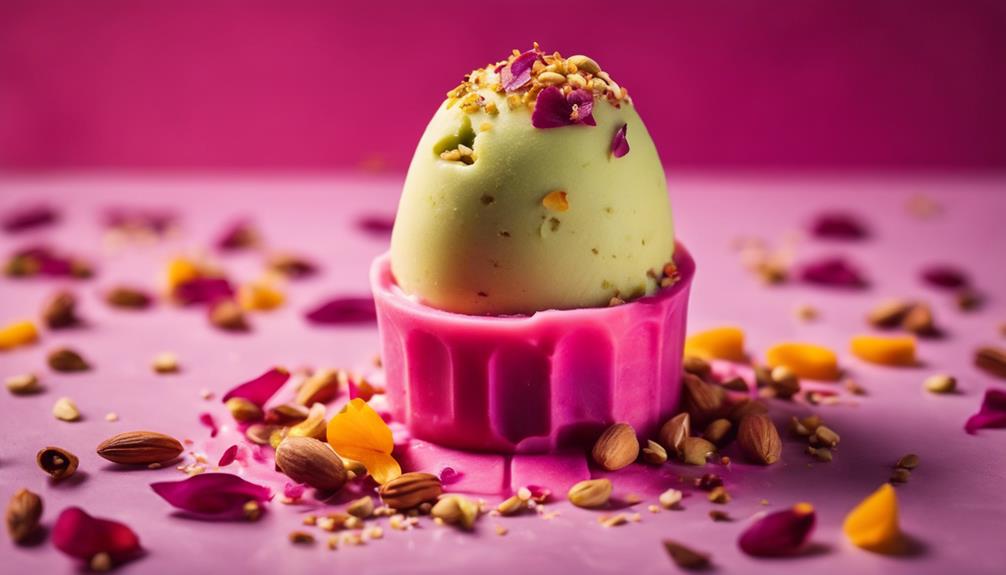The history of Gelato is as delightful as its flavor. It dates back to around 3000 BC, originating from ancient civilizations combining ice and flavorings. Egyptian pharaohs used frozen desserts to impress their guests, and during the Italian Renaissance, Bernardo Buontalenti created a creamy gelato for Spanish royals, leading to its popularization in Europe by Francesco Procopio. By the late 18th century, gelato had made its way to the streets of New York City. Today, gelato is known for its emphasis on fresh ingredients and innovative flavors. It is more than just a dessert; it is a representation of hospitality and culture. Stay tuned to learn more about the evolution of this delightful treat.
Key Takeaways
- Gelato's origins date back to ancient civilizations, with frozen desserts enjoyed as early as 3000 BC in Asia and 2500 BC in Egypt.
- The Italian Renaissance saw significant advancements, with Bernardo Buontalenti creating creamy gelato for Spanish royals in the late 1500s.
- Francesco Procopio dei Coltelli popularized gelato in Europe and invented the first ice cream-making machine for large-scale production.
- Gelato has evolved over time, with modern trends emphasizing fresh, local ingredients and innovative flavors while maintaining its Italian heritage.
Historical Origins of Gelato
Gelato's rich history dates back to ancient civilizations, where people mixed ice and snow with flavorings around 3000 BC in Asia.
Even the Egyptian pharaohs were aware of how to indulge their guests with frozen desserts, sweetening ice with fruit juices as far back as 2500 BC.
This early luxury paved the way for what would become the beloved treat we recognize today.
The Italian Renaissance marked a significant turning point for gelato. In the late 1500s, Bernardo Buontalenti created a creamy version of this frozen dessert for Spanish royal guests, showcasing the artistry behind gelato-making.
Fast forward to the late 17th century, and you'll find Francesco Procopio dei Coltelli popularizing gelato in Europe at his Paris café, The Procope.
He didn't just serve gelato; he also developed the first ice cream-making machine, making it possible to produce this delightful dessert on a larger scale.
Cultural Significance of Gelato

When you enjoy gelato, you're not just savoring a treat; you're experiencing a symbol of hospitality that dates back to ancient civilizations.
This delicious dessert has evolved into a staple of Italian culture, reflecting culinary innovation and tradition.
As you partake in gelato, you connect with a rich history that celebrates community and shared experiences.
Symbol of Hospitality
Throughout history, gelato has served as a symbol of hospitality, reflecting generosity and social status in various cultures. In ancient Egypt, pharaohs delighted their esteemed guests with ice sweetened by fruit juices, showcasing their wealth and commitment to hospitality. This early use of frozen treats set the stage for gelato's evolution.
During the Renaissance, gelato gained popularity among Italy's elite, becoming a fashionable delicacy that further emphasized luxury and social status. The influential Medici family played a pivotal role in promoting gelato to royal courts, helping to establish it as an essential element of Italian culinary culture and hospitality.
Today, gelato shops are community hubs, inviting social interaction and reinforcing its significance as a welcoming treat. Festivals celebrating gelato around the world spotlight its cultural importance, emphasizing how this sweet indulgence brings people together.
Whether enjoyed at a lavish banquet or a casual gathering, gelato remains a delightful expression of hospitality, inviting you to share moments of joy and connection. In every scoop, you taste a tradition that transcends time, symbolizing warmth and generosity across cultures.
Culinary Tradition and Innovation
Culinary tradition and innovation intertwine in gelato, as artisans blend time-honored recipes with creative flavors to craft a unique frozen experience. This beloved treat has roots that trace back to ancient civilizations, where it was a custom for Egyptian pharaohs, showcasing social status and hospitality.
During the Italian Renaissance, gelato evolved considerably, reflecting advancements in culinary techniques and gaining popularity among the elite, particularly with the influence of the Medici family. As gelato made its way to France in the 16th century, it solidified its status as a fashionable delicacy throughout Europe.
Today, modern gelato continues this tradition, with artisan gelato shops emerging as community hubs that prioritize local ingredients and traditional production methods. These shops not only serve delectable frozen treats but also foster connections among patrons.
Around the world, gelato festivals celebrate its cultural importance, highlighting innovative flavors and the craftsmanship behind this iconic dessert. By embracing both historical roots and contemporary creativity, gelato remains a reflection of the rich culinary heritage that brings people together across generations.
Key Differences From Ice Cream

Gelato stands apart from ice cream mainly due to its lower butterfat content and denser texture, which create a unique taste experience. While traditional ice cream contains a higher butterfat level, gelato has approximately two-thirds less, making it a lighter, yet often more flavorful option. This difference in butterfat allows gelato to shine through with a more pronounced sweetness, thanks to its higher sugar content.
Another key distinction lies in how these frozen treats are churned. Gelato is churned slowly, incorporating considerably less air, which results in a denser texture that enhances its creaminess. You'll notice this difference when you savor a scoop; gelato feels richer and more indulgent on your palate.
Additionally, gelato is typically served at slightly higher temperatures than ice cream, ranging from 10°F to 20°F, while ice cream is stored at -20°F or colder. This warmer serving temperature allows the flavors to emerge more distinctly, making your experience even more enjoyable.
Evolution of Gelato Over Time

The journey of gelato from its royal origins to its modern-day artisanal form showcases how this delightful treat has transformed over centuries. Originating in the 16th century, Bernardo Buontalenti crafted a creamy frozen dessert for the Spanish royal court, establishing the foundation of gelato as we understand it. Fast forward to the late 18th century, and you'll find Giovanni Basiolo introducing gelato to the streets of New York City, marking its entry into American culture.
Technological advancements in the early 20th century revolutionized gelato production, making it more accessible to everyone. By the late 1990s, a shift towards artisanal gelato emerged, focusing on fresh ingredients and traditional methods to counter mass production.
Here's a quick look at gelato's evolution:
| Era | Key Development |
|---|---|
| 16th Century | Royal origins in Spain |
| Late 18th Century | Introduction to American streets |
| Early 20th Century | Advancements in refrigeration |
| Late 1990s | Rise of artisanal production |
| Today | Unique recipes with lower fat content |
This evolution guarantees gelato remains a delicious, uniquely Italian treat that continues to delight taste buds worldwide.
Modern Gelato Trends

As consumers increasingly crave unique flavor experiences, modern gelato trends are embracing fresh, local ingredients and innovative combinations. You'll notice the artisanal gelato movement focusing on authentic flavors, with many gelato makers steering clear of artificial additives. This commitment to quality allows you to enjoy the rich taste of gelato made from fresh ingredients.
Social media plays a huge role in this trend, as visually stunning presentations of gelato entice you to explore new shops and flavors. You'll find unique flavors like lavender honey and matcha green tea, which go beyond the traditional chocolate and vanilla. These exotic options cater to adventurous palates seeking something different.
Moreover, the shift towards health-conscious desserts has led to the creation of lower-calorie and dairy-free gelato choices, making it easier for everyone to indulge. Gelato festivals around the world celebrate these innovations, bringing communities together to appreciate the craft of gelato makers.
Notable Gelaterias Worldwide

When you think about iconic gelato shops, several names likely come to mind that redefine flavor and quality.
Each gelateria offers unique flavor offerings and innovative techniques that elevate your gelato experience.
Let's explore some notable spots around the world that are making waves in the gelato scene.
Iconic Gelato Shops
Iconic gelato shops around the world offer a delightful taste of tradition and innovation, enchanting both locals and travelers with their unique flavors and high-quality ingredients.
In Rome, Il Gelato Di San Crispino stands out for its dedication to natural flavors and unique preparation methods that elevate the taste of Italian ice cream. Just a stone's throw away, Gelateria del Gracchi delights patrons with its exceptional pistachio gelato and gluten-free options, making it a must-visit spot.
You won't want to miss Gelateria del Teatro ai Coronari, where pastry techniques merge with gelato-making to create innovative flavors that redefine dessert experiences. Al Settimo Gelo and Il Gelato Fior Di Luna take sustainability seriously, emphasizing organic ingredients in their gelato production.
Meanwhile, GROM, founded in Turin in 2003, gained global recognition for its commitment to high-quality, organic ingredients and traditional gelato-making techniques. With multiple locations worldwide, GROM showcases how the essence of gelato remains timeless while adapting to modern tastes.
These iconic gelaterias not only preserve the art of gelato but also pave the way for a sustainable future in this beloved treat.
Unique Flavor Offerings
Notable gelaterias worldwide are redefining the dessert landscape with their imaginative and unique flavor offerings that tantalize your taste buds. These shops elevate the ritual of eating gelato, transforming it into an unforgettable experience.
Here are three standout gelaterias worth exploring:
- Il Gelato Di San Crispino (Rome) – Renowned for its delicious Italian gelato, this gelateria emphasizes organic and natural ingredients, ensuring every scoop is free from artificial flavorings.
- Gelateria del Gracchi – Famous for its exceptional pistachio gelato, it offers gluten-free options, showcasing a commitment to quality and flavor diversity that appeals to all gelato lovers.
- Gelateria Fata Morgana – Known for its innovative and unique flavor combinations, this gelateria pushes boundaries, blending unexpected ingredients for a truly adventurous taste.
These gelaterias not only serve gelato but also celebrate the art of creating unique flavor combinations.
Health Aspects of Gelato

Gelato offers a lighter dessert option with fewer calories and lower fat content compared to traditional ice cream, making it a healthier choice for indulgence. When you're mindful of your calorie intake, gelato can satisfy your sweet tooth without the guilt. Its lower fat content not only makes it a better choice but also allows the rich flavors of natural ingredients to shine through.
Many gelato varieties are crafted with natural ingredients, minimizing artificial additives that are often found in mass-produced ice creams. This focus on quality means you can enjoy a treat that aligns more closely with a healthier lifestyle. Plus, if you're lactose intolerant or prefer non-dairy options, you'll find gelato flavors made with dairy alternatives, broadening your choices.
The nutritional benefits of gelato really depend on the specific ingredients used, with fresh, seasonal offerings generally providing higher nutrient value. By opting for gelato, you can indulge in a delicious dessert while being aware of the health aspects, enjoying the taste without compromising your commitment to a balanced diet.
Frequently Asked Questions
What Is the History of Gelato?
You'll find gelato's history fascinating; it began in 16th century Italy, gained popularity in the U.S. in 1770, and evolved with technology in the 19th century, leading to today's diverse, artisanal creations.
Who Brought Gelato to America?
Imagine the delight of cooling down on a hot day—Giovanni Basiolo introduced gelato to America in 1770. His arrival in New York City set the stage for a sweet revolution that still enchants you today.
What Are Some Fun Facts About Gelato?
Did you know gelato has about two-thirds less butterfat than ice cream? It's served warmer, enhancing flavor. Plus, artisanal shops focus on fresh ingredients, and there are festivals celebrating this delicious treat worldwide!
Where Does the Word Gelato Come From?
The word "gelato" comes from the Italian verb "gelare," meaning "to freeze." It emphasizes the creamy texture of this frozen dessert, distinguishing it from traditional ice cream with its unique preparation method and lower fat content.
What Are the Origins of Gelato and How Is It Traditionally Served?
Gelato, a creamy frozen dessert, has its origins in Italy, where it is traditionally served in a cone or cup. However, a modern gelato sandwich twist tradition has emerged, with enthusiasts enjoying gelato between two cookies or wafers. Despite this twist, the traditional serving methods remain popular.
How has the traditional gelato recipe evolved to incorporate gelato sandwiches?
The traditional gelato recipe has evolved over time to incorporate a gelato sandwich twist tradition. While gelato is typically enjoyed in cups or cones, the idea of sandwiching it between two cookies or wafers has added a fun and delicious spin to this classic treat.
Conclusion
In the world of frozen treats, gelato stands apart, blending tradition with innovation.
While it harks back to centuries of craftsmanship, it also embraces modern flavors and health-conscious ingredients.
You can savor its rich, creamy texture, feeling the warmth of its history, yet relish the excitement of new trends.
Gelato isn't just a dessert; it's a cultural experience that evolves, inviting you to indulge in both the past and the present with every delightful scoop.
















